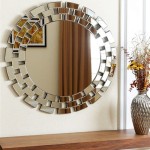How To Put On Side Mirror Covers
Side mirror covers, also known as mirror caps, offer a simple yet effective way to personalize a vehicle's aesthetics or replace damaged components. Proper installation ensures a secure fit and prevents loss while driving. This guide provides a comprehensive approach to installing side mirror covers on most vehicles.
Preparation is Key
Before beginning the installation process, gather the necessary tools and materials. These typically include the new side mirror covers, a small flathead screwdriver or plastic pry tool, and potentially some cleaning materials like isopropyl alcohol and a microfiber cloth.
Cleanliness is crucial for proper adhesion, especially if using covers with adhesive backing. Thoroughly clean the existing mirror housing with isopropyl alcohol to remove dirt, grime, and wax residue. This ensures a strong bond and prevents the cover from detaching prematurely. Allow the surface to dry completely before proceeding.
Understanding Mirror Cover Types
Side mirror covers are generally categorized into two main types: clip-on/snap-on and adhesive-backed. Each type requires a slightly different installation approach.
Installing Clip-On/Snap-On Mirror Covers
Clip-on or snap-on covers are designed to securely attach to the existing mirror housing using clips or tabs integrated into the cover itself. Alignment is critical for a successful installation.
Carefully examine the new mirror cover and locate the clips or tabs. Similarly, identify the corresponding grooves or slots on the existing mirror housing where these clips will engage. This often requires a close visual inspection of both components.
Begin by aligning the cover with the mirror housing, ensuring all clips and tabs are positioned correctly over their corresponding slots. Gently but firmly press the cover onto the housing. A series of audible clicks usually indicates that the clips have engaged and the cover is securely attached.
Once installed, gently tug on the cover to verify its secure attachment. It should not move or feel loose. If any sections feel loose or unstable, re-examine the alignment and repeat the installation process.
Installing Adhesive-Backed Mirror Covers
Adhesive-backed covers rely on a strong adhesive to bond directly to the mirror housing. Proper surface preparation is essential for long-lasting adhesion.
After thoroughly cleaning the mirror housing, carefully peel back a small portion of the adhesive backing from the new cover. Avoid touching the exposed adhesive to prevent contamination.
Align the cover with the mirror housing, starting with the exposed adhesive section. Once aligned, firmly press this section onto the housing to initiate the bonding process.
Gradually peel back the remaining adhesive backing while simultaneously pressing the cover onto the housing. Work slowly and methodically to ensure proper adhesion and prevent air bubbles or wrinkles.
Once the entire cover is adhered, apply firm and even pressure across the surface for a minute or two to ensure a strong bond. Avoid excessive pressure, which could damage the cover or the underlying mirror housing.
Post-Installation Inspection
Regardless of the cover type, a post-installation inspection is essential to ensure proper fit and function. Visually inspect the cover for any gaps, misalignments, or loose sections.
Gently test the cover's stability by applying light pressure. It should remain firmly attached and not exhibit any movement or looseness.
If any issues are detected, carefully remove the cover and repeat the installation process, paying close attention to alignment and adhesion. For adhesive-backed covers, additional adhesive may be necessary if the original adhesive fails to bond properly.
Addressing Common Issues
Difficulty aligning the cover: Ensure the cover is oriented correctly and that all clips or tabs are aligned with their corresponding slots. If necessary, use a small flathead screwdriver or plastic pry tool to gently guide the clips into place.
Loose or unstable cover (clip-on/snap-on): Re-examine the alignment and ensure all clips are fully engaged. If the clips are damaged or broken, replacement covers may be required.
Loose or unstable cover (adhesive-backed): Clean the mirror housing again with isopropyl alcohol and ensure the surface is dry. Reapply the cover, applying firm and even pressure. If the adhesive is weak or ineffective, consider using additional automotive-grade adhesive.
Air bubbles or wrinkles under the cover (adhesive-backed): Carefully peel back the affected area and reapply, smoothing out any air bubbles or wrinkles as you go. A plastic squeegee or credit card can be helpful for this process.
Maintaining Your Side Mirror Covers
Regular cleaning with soap and water or a dedicated automotive cleaner helps maintain the appearance and prolong the lifespan of your side mirror covers. Avoid harsh chemicals or abrasive cleaners, which can damage the cover's finish.
Periodically inspect the covers for any signs of damage, looseness, or wear. Address any issues promptly to prevent further damage or loss of the covers.

How To Remove Side Mirror Cover On Ford Focus Mk3

Quick Fix For Lost Mirror Cover 2007 Saab 9 5 Linear Trionic Seven

Ford Focus Side View Mirror Cover Removal Replacement 2024

How To Remove Side Mirror Cap

How To Change Wing Mirror Cover On Volvo V90 S90 Xc90 V60 S60 Xc60 Xc40

3 Ways To Replace A Car S Side View Mirror Wikihow

How To Take Mirror And Back Cover Off Plus Carbon Fiber Wrap Lexus Is300 Sportcros

3 Ways To Replace A Car S Side View Mirror Wikihow

Side Mirror Wing Back Cover Replacement

How To Interior Exterior Replace Mirror Covers Without Breaking The Clips North American Motoring








